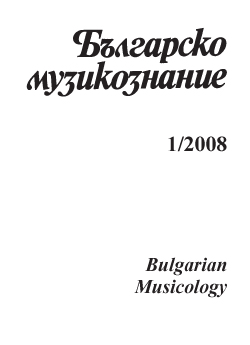Симетричноладовото музикално мислене на Димитър Ненов в Етюд за пиано № 1
The Symmetrical-Modal Musical Thought of Dimitar Nenov in Piano Etude № 1
Author(s): Nikolay GradevSubject(s): Music
Published by: Институт за изследване на изкуствата, Българска академия на науките
Summary/Abstract: Dimitar Nenov wrote Piano Etude № 1 in 1931. The composer’s selection of the total modal organization of the hemiditone symmetrical mode (octatonic scale, whole-tone half-tone scale, diminished scale, Example 1) is the reason that the thematization of the modal regularities was transformed into a basic form-creating factor. Three pages of rough sketches have been preserved in Nenov’s archive (Example 2). They represent three stages in Nenov’s work on the composition (April, May and July 1931) and allow the progress of the composer’s creative process to be traced and “reconstructed.” Changes in the work’s modal-harmonic organization bear witness to the purposeful, compositionally motivated restructuring of the entire modal picture (Examples 3, 4 and 5). One of the many signs of that is the change in the main theme’s cadential moments in the final version as compared to the original version (see measures 4 and 8 in Examples 3 and 5). A comparison shows that in Dimitar Nenov’s symmetrical-modal composition system, in contrast to “classical” tonal musical thinking, the cadences turn out to be fluid parts of the musical form, and the initium – a stable modal-thematic idea. The same artistic logic led him to end the piece with a transposition different from the opening one. The connection between them is the „tonally-centering“ tritone (the augmented fourth c-fi s) as an element of the central chord from the dissonant tonality c-fi s-h. In this way, Nenov reached a new, contemporary understanding of the tonal unit adequate to the chosen symmetrical-modal system. As a result of structural-thematic changes in the final version of the etude, a new, wider interrelationship is apparent between the parts of the form, which make it a diminishing musical construction. The individual, specifically Nenov-style characteristics in the work are found in the “search for the new, as-of-yet unsaid” through the rethinking of a traditional musical form as a “structural matrix” for a new, contemporary way for the composer to express himself.
Journal: Българско музикознание
- Issue Year: 2008
- Issue No: 1
- Page Range: 39-61
- Page Count: 23
- Language: Bulgarian
- Content File-PDF

